
The latest forecasts have much above normal temperatures a feature for July, into early August in the Cornbelt.
This would be an awful environment for early grain fill of corn.........what we call "heat fill"
A difference of 6 deg. F during the 6 weeks after pollination can make a difference in 30 bushel/acre in yields...........even with great rains.
Night time temps(and humidity) are by far the most important in determining the rate of corn filling. The warmer that it is, the shorter the period that the corn has to fill its kernels. The cooler that it is, the longer the period is stretched out..........sometimes an extra 2+ weeks in cool Summers vs hot Summers which really give the kernels extra time to get pumped up with energy from photosynthetic processes that take place during the day.
Frequently, when you have cool nights with low humidity, you will also have clear skies, which would also cause abundant sunshine during the day(which all plants collect to make energy, along with the extra CO2, water and minerals-especially nitrogen for corn).
The just out 45 day prediction below is for the Midwest from the European model. These long range forecasts don't have great skill but this one is incredibly warm(hot) to the point of us having reasonable confidence that there will be more than average heat and possibly widespread major heat, along with yields losses to corn from heat fill.
Even modest heat for much of the Summer will subtract over 10 bushels/acre from yields in many places compared to cooler temps.
Turn your attention to the graph on the right below........cooling degree days. The green line is average for the next 45 days. The gold line the previous forecast from 3 days ago. The purple line is the just updated one.
The purple line shows temperatures staying elevated at around 2 degrees above average during all of pollination and early filling for corn. This WILL reduce yields, even with abundant rains, probably enough to keep them below records, even with great rains.
The heat will also increase evapotranspiration and moisture needs as well as dry out soils quicker, so any places that are short on rainfall, will suffer moisture deficiency issues. Helping to counter this will continue to be the the entirely beneficial affects of increasing CO2.
Also, with the atmosphere set up to have a heat ridge developing in the Plains/Midwest, a small change can quickly turn things very bullish. A heat ridge in the S.Plains that allows perturbations in the jet stream to the north to drop into the Midwest may favor good rain events. A slight strengthening or shifting farther north, means the Cornbelt, especially the southern half is UNDER the rain suppressing dome of warm air aloft, with soils drying out and temps approaching 100 degrees.
The Tropical Pacific is in a weak La Nina mode right now, which also increases odds based on history for a Summer that features a persistent heat ridge................somewhere in the US.
.png)
Producers and traders may remember the surprise we got 10 years ago during the corn crop harvest.
Yields across the central and especially the Southern Cornbelt came in as much as 20 bushels/acre less than expected/predicted in the warmest locations.
It was hot and wet during the Summer of 2010. Crop ratings stayed very high because of all the rains. The corn plants all looked great from the outside. The market was trading a near record crop. But the heat caused accelerated maturity..........heat fill.
When they actually got into the corn, instead of plump kernels, they found small kernels.
The hotter it is, the faster the corn plant matures(accumulates heat units or growing degree days). The faster it matures, the less time it has to fill the kernels. Less time filling, means less filling and smaller kernels.........period.
It's an irrefutable law of agronomy that can't be offset by any amount of rain or other factors.
The heat won't hurt the beans but it WILL reduce production for corn from wherever it would be in those areas that average temps well above normal (for more than just a few days) because kernels will be smaller.......kernel weight lower. The longer the heat lasts, the greater the effect.
Conversely, cool temperatures do the opposite and maximize yields.
https://www.pioneer.com/us/agronomy/high-night-temps-yield.html
2010 Growing Season
https://www.pioneer.com/us/agronomy/high-night-temps-yield.html
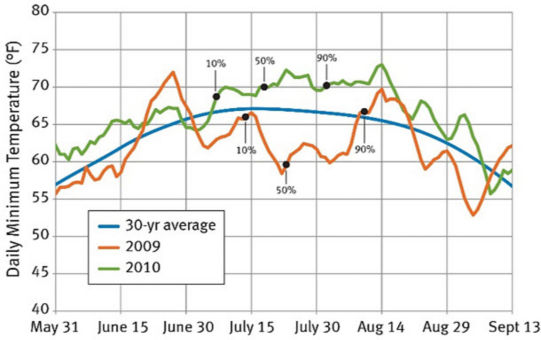
Figure 1. Daily minimum temperatures (7-day moving average) for Des Moines, IA, in 2009 and 2010, and 30-yr average minimum daily temperatures (1981-2010). Approximate dates of 10%, 50%, and 90% silking in Iowa in 2009 and 2010 based on USDA crop progress reports.
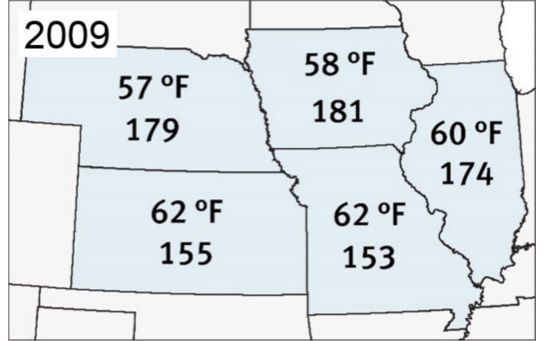
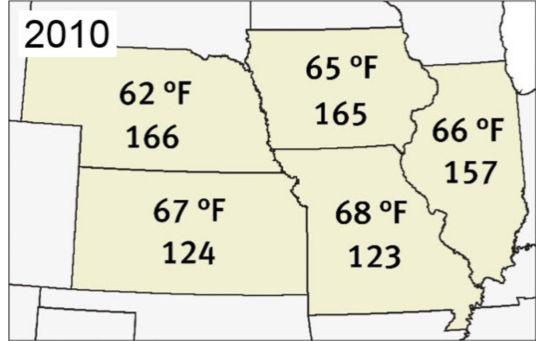
Figure 2. Average minimum temperatures experienced in July-August of 2009 (top) and 2010 (above) and average yields (bu/acre) in Iowa, Illinois, Missouri, Kansas and Nebraska. Data from NCEI NOAA, USDA NASS.
ICM News
by Roger Elmore, Department of Agronomy
"October corn yield forecast for Iowa dropped to 169 bushels per acre, a significant reduction from the August and September forecasts of 179 bushels per acre (see October USDA-NASS forecast). If realized, 2010 yields will rank sixth among the last seven years, higher only than the yields of 2006 (166 bushels per acre). Numerous published and anecdotal yield reports substantiate lower than expected yields this year.
In previous 2010 Integrated Crop Management News articles, we've addressed 2010 conditions and the possibility of reduced yields resulting from rapid crop development following silking (see September 28 article). Statewide Growing Degree Day accumulations were 116 percent of normal during most of the seed fill period — silk to dent — this year."
Table 2. Effect of temperature on grain fill duration, grain weight per plant and kernel number (Badu-Apraku et al., 1983).

So lets look ahead at the next 2 weeks. Early pollination will be taking place, probably successfully at most places with temperatures needing to get well into the 90's to cause issues.
The crop was planted early in many places but has not pollinated yet in the main cornbelt(silking)
https://release.nass.usda.gov/reports/prog2620.txt
Temperatures compared to average for days 3-7 below
Very Warm to Hot but not quite hot enough to affect pollination a great deal.
https://www.wpc.ncep.noaa.gov/medr/medr_mean.shtml
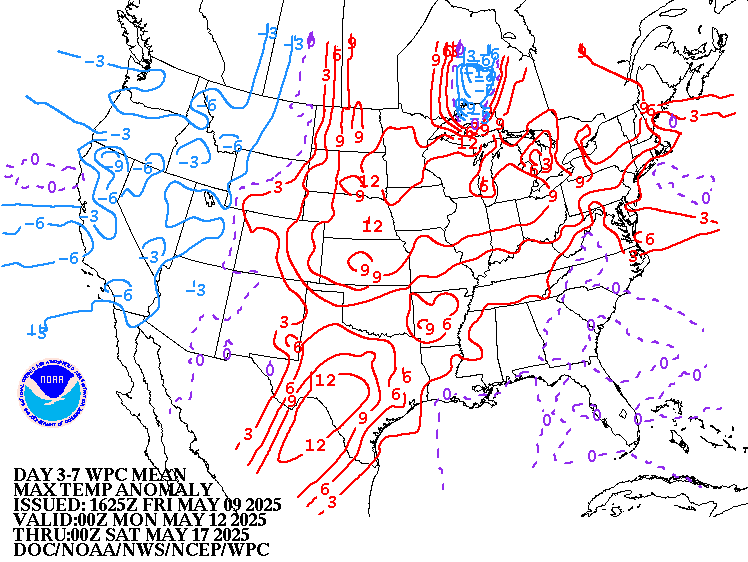
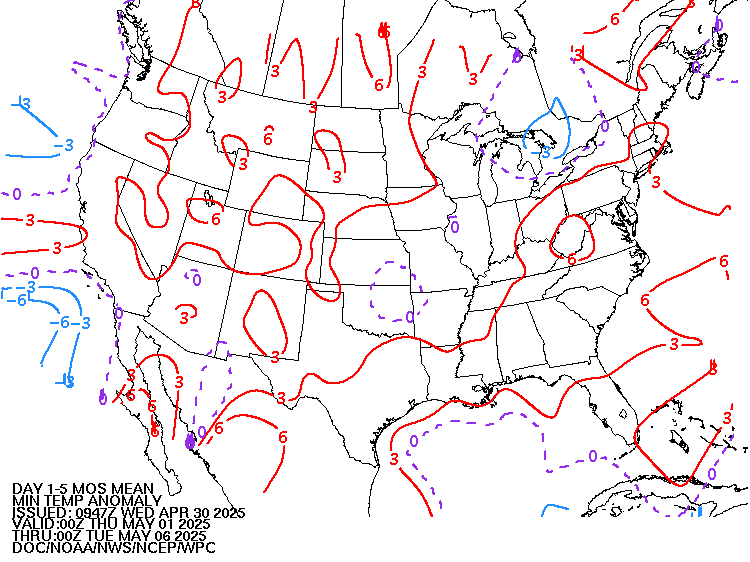
Extended forecasts below
Temperature Probability
| the 8-14 day outlooks ArchivesAnalogsLines-Only FormatGIS Data | |
Temperature Probability | |
 | |
https://cropwatch.unl.edu/how-extended-high-heat-disrupts-corn-pollination-0
"Even with adequate moisture and timely silking, heat alone can desiccate silks so that they become non-receptive to pollen. While this is a bigger problem when humidity is low, it is apparent that it is happening this year, especially on hybrids that silk quite early relative to pollen shed. Even with dew points in the 70s, when temperatures reach the high 90s to the100s, the heat can still desiccate silks and reduce silk fertility.
Heat also affects pollen production and viability. First, heat over 95°F depresses pollen production. Continuous heat, over several days before and during pollen-shed, results in only a fraction of normal pollen being formed, probably because of the reduced sugar available. In addition, heat reduces the period of pollen viability to a couple hours (or even less). While there is normally a surplus of pollen, heat can reduce the fertility and amount available for fertilization of silks. It's been shown (Herrero and Johnson, see Resources) that prolonged exposure to temperatures reduced the volume of pollen shed and dramatically reduced its viability."
According to Elwin Taylor, Iowa State University (ISU) climatologist, and Roger Elmore, ISU crop production agronomist, we are seeing an oscillating weather pattern where above normal temperatures east of the Continental Divide are likely to persist for up to six weeks. In the past, such patterns have been consistently associated with below trend corn yields for the U.S.
The insidious part of this pattern is that extended periods of heat tend to diminish yields even more. When soil moisture is sufficient, one day of 95-98°F has little or no impact on yields. However, after the fourth consecutive day there tends to be a 1% loss in yield for each day above that temperature. After the fifth or sixth day, there tends to be even greater potential for yield loss. While it is difficult to make yield loss predictions from heat and drought stress in any year, the stress does add up and take a toll on the crop."
• Long stretches of high temperatures may affect corn pollination.
• Hot weather can reduce viability, production, and the release of pollen grains.
• Silk viability can be reduced under extreme high temperatures before pollen shed.
• Timing of pollen shed, silking, and hot temperatures play a role in how heat affects the pollination process.
Thanks for all this information ! We have had 2.7" rain the past few days, and I was feeling pretty good about the crop. Thanks for the reminder that things can change in a hurry !
2.7 inches of rain!
You are in great shape bowyer, congrats.
How long before you start tassling?
I thought there was several weeks from start to finish for you but maybe your early corn is getting close to tassling?
We did get an early start to planting (around April 22) , but it was so cool that there was very little growth. The later planted corn planted into the warm soil, popped right up and grew fast. The tallest corn here is maybe shoulder high and should start tasselling around July 4th. Some years here corn will tassel late June and fields will be fully tasselled by the 4th. Last year a lot of corn was barely a foot tall on July 4.
As they say.................the forecast is "Hot as a firecracker!" (-:
The outlook continues to advertise hot weather lasting past pollination, into early filling for corn.
Heat fill to start kernel filling this year!
Even with good rains, heat fill will take away yields. Dry weather too and hot temps, especially night time temps well above 70 for weeks, will knock corn yields down by as much as 25 bu/acres in large areas affected.
Heat fill coming up for corn
Started by metmike - June 25, 2020, 7:52 p.m.
After the forecasts cooled off during the 2nd half of July, minimizing heat fill issues......especially right now as we experience near optimal filling weather..........the forecast has heated back up again for much of August and there WILL be some heat fill, that reduces yields in some places, regardless of great rains.
The deal there is that we never find out until harvest because heat fill with tons of rain, results in excellent looking plants on the outside and tiny kernels inside.